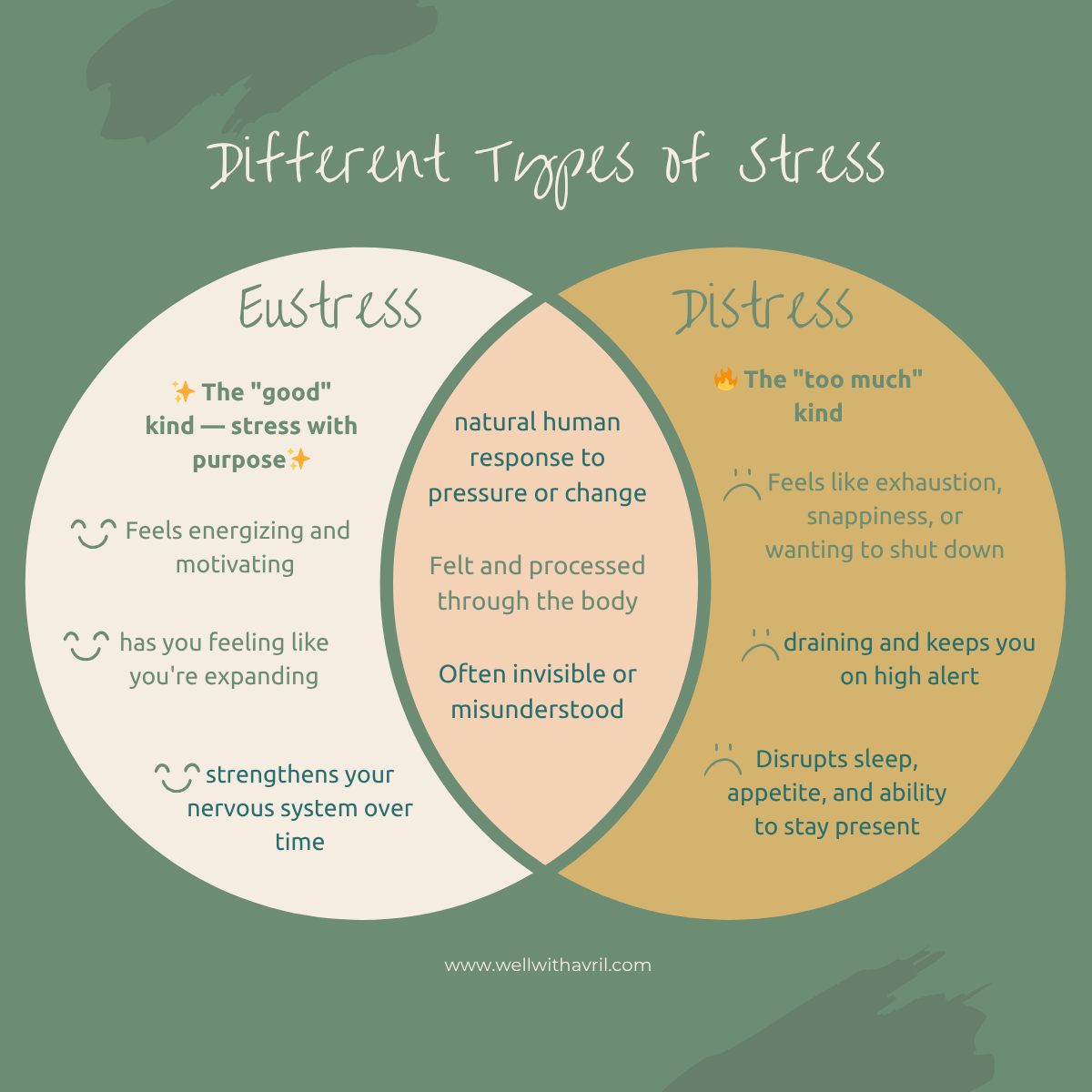Befriending Stress: The Hidden Toll of Microstressors and How to Take Back Control
We’ve been Thinking About Stress All Wrong
Stress isn’t always loud. It doesn’t always show up as a deadline, a crisis, or a breakdown. Sometimes, stress hides in the quiet moments—the skipped lunch, the 14th back-to-back meeting, or the way your breath shortens every time you say “yes” when you really mean “no.”
The truth is: stress is a natural part of being human. We’re not here to eliminate it entirely. Instead, the invitation is to understand it, work with it, and recognize its nuances—especially the hidden ones.
Not All Stress is Bad
We often hear about stress in extremes. But there are actually two kinds:
Eustress is beneficial—it energizes and motivates us. Think: preparing for a promotion or gearing up for a life-changing trip.
Distress is the harmful kind—it overwhelms, depletes, and leads to burnout.
Not all stress are the same. Some are beneficial, especially in short bursts, while some are harmful. Nonetheless, stress is natural. Both types are felt and processed through the body. And, both can sometimes be invisible or misunderstood from the outside.
But what often slips through the cracks is the chronic low-level stress we normalize every day—the kind we’ve learned to live with. These are the hidden stressors, and they’re quietly costing us more than we realize.
The Hidden Stressors We Overlook
A Harvard Business Review study identified 14 common sources of microstress—small, repeated interpersonal stressors that, while seemingly minor, accumulate over time and lead to profound emotional fatigue.
Here are a few of those hidden stressors:
Unpredictable behavior from people we depend on
Pressure to pursue goals we don’t fully control
Misalignment between your values and your work
Negative energy from others
Constant disruptions to focus and flow
Feeling responsible for others’ emotions
Being overlooked or unacknowledged
Technology that fragments our attention
On their own, these seem manageable. But they don’t happen in isolation. They ripple through our nervous system, relationships, and habits—especially for women juggling high-pressure careers and caregiving roles.
The Ripple Effect
Take the example of a high-achieving woman in her 20s and 30s climbing the corporate ladder. Her job is fast-paced, rewarding—and relentless. She doesn’t always notice how tension builds from the small things: her manager’s unpredictability, that Slack ping during her break, her growing disconnect from personal goals she’s shelved for “someday.”
By the end of the week, she’s not just tired—she’s emotionally flatlined. She tells herself she needs rest, so she stays in to collect herself. But instead of truly recharging, she ends up doom-scrolling online and numbing out, slipping deeper into emotional disconnect. She skips her weekend yoga, avoids catching up with friends, and starts the next week already depleted.
This isn’t dramatic burnout. It’s microstress in action. And it compounds over time.
The Superwoman Strain: How Success Can Mask Microstress
High-achieving women are especially vulnerable to this because they often carry invisible internal and external expectations. Many operate under what researchers call the Superwoman Schema: the belief that they must be strong, suppress emotion, resist vulnerability, and effortlessly succeed while balancing multiple roles in life as wife, mother, worker, homemaker, caregiver, etc. According to a study published in the National Library of Medicine, this chronic high-functioning exterior—especially among women of color—can contribute to long-term psychological and physiological stress. Even when they appear composed, many women are navigating an ongoing inner storm of pressure, perfectionism, and performance.
When society praises resilience without providing real support, the cost of holding it all together goes unrecognized—until it shows up in the body, the breath, and the burnout.
Befriending Stress: What it Really Means
“Befriending” stress doesn’t mean tolerating or ignoring it. And it’s definitely not about toxic positivity. It means building a more honest, curious relationship with how stress shows up in your life.
You might start by asking:
What small moments in my day feel heavier than they should?
Where do I notice tension in my body—and what might it be trying to tell me?
What habits do I turn to when I feel emotionally overloaded?
What boundaries (with others or myself) feel leaky or undefined?
What would it look like to respond to stress with care instead of control?
From there, you can begin experimenting with small shifts—guided not by perfection, but by what feels nourishing. It could look like blocking time for a proper lunch. Turning off notifications outside of work. Saying no to last minute requests or that one more Zoom call. Or finally starting that breathwork practice you keep putting off.
You don’t have to overhaul your life. You just need to start paying attention—then respond with care.
Final Thoughts: Stress Isn’t the Enemy
Stress is a signal. A message. A teacher. It tells us when something’s off, when we’re over capacity, or when our boundaries need reinforcement.
When we learn to befriend stress—not fear it—we start to move differently. We stop running on empty and start living with intention. And that’s where true alignment begins.
Ready to Befriend Your Stress?
Start with small steps. Join us for 5 Day Stress Awareness Challenge for a gentle, guided reset to help identify and shift the microstressors or hidden stress stealing your energy. Because the stress you ignore is the stress that controls you. And, the stress you befriend? That’s where your power lies.

